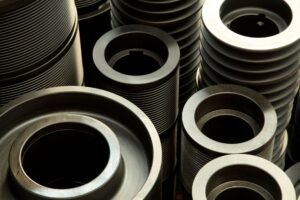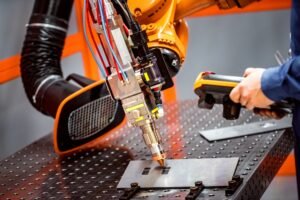Introduction
Aluminum and stainless steel are two of the most commonly machined metals in manufacturing. While both materials are widely used, they have distinct properties that affect machining processes, costs, and end-use applications. This article compares aluminum vs stainless steel CNC machining in terms of differences, challenges, and best use cases to help you choose the right material for your project.
1. Material Properties Comparison
| Property | Aluminum | Stainless Steel |
|---|---|---|
| Density | Lightweight (approx. 2.7 g/cm³) | Heavy (approx. 7.8 g/cm³) |
| Strength | Moderate strength, high strength-to-weight | High tensile and yield strength |
| Corrosion Resistance | Naturally corrosion-resistant (anodizing improves) | Excellent corrosion and chemical resistance |
| Thermal Conductivity | Excellent heat dissipation | Lower thermal conductivity |
| Machinability | Very easy to machine, less tool wear | Harder to machine, higher tool wear |
| Cost | Generally lower cost | More expensive per unit weight |
2. CNC Machining Aluminum
Advantages:
- High Machinability: Aluminum is soft and easy to cut, enabling high-speed machining with less tool wear.
- Excellent Surface Finish: Achieves smooth finishes with minimal effort.
- Lightweight: Ideal for weight-sensitive applications like aerospace and automotive parts.
- Thermal Conductivity: Suitable for components requiring heat dissipation (e.g., heat sinks).
Challenges:
- Material Softness: Prone to deformation under heavy loads.
- Built-up Edge (BUE): Aluminum can stick to cutting tools, affecting surface finish and accuracy.
- Oxidation: Though corrosion-resistant, aluminum can oxidize and may require anodizing for added protection.
Common Applications:
- Aerospace components
- Automotive parts
- Electronics housings
- Consumer products (laptops, phones)
- Prototypes and fixtures
3. CNC Machining Stainless Steel
Advantages:
- High Strength and Durability: Suitable for structural and load-bearing applications.
- Corrosion and Chemical Resistance: Performs well in harsh environments (marine, medical, food processing).
- Excellent Surface Hardness: Offers superior wear resistance.
Challenges:
- Difficult Machinability: Hardness leads to increased cutting forces, slower machining speeds, and faster tool wear.
- Heat Generation: Low thermal conductivity can cause heat buildup, requiring effective cooling strategies.
- Higher Costs: Material cost and longer machining times increase overall expenses.
Common Applications:
- Medical devices and surgical instruments
- Food processing equipment
- Marine and offshore components
- Industrial machinery parts
- High-strength automotive components
4. Tooling and Machining Strategies
| Factor | Aluminum Machining | Stainless Steel Machining |
|---|---|---|
| Cutting Speed | High cutting speeds (up to 500 m/min) | Lower speeds (typically below 60 m/min) |
| Tool Material | Carbide tools preferred | Coated carbide or ceramic tools recommended |
| Coolant Usage | Minimal or air blast often sufficient | High-pressure coolant essential |
| Tool Wear | Slow tool wear | Rapid tool wear, frequent tool changes |
| Chip Evacuation | Easy with air blast | Requires efficient chip removal systems |
5. Which Material Should You Choose?
- Choose Aluminum if:
- Weight reduction is critical.
- You need high machining speeds and lower production costs.
- The part is for consumer electronics, automotive, or aerospace applications.
- Choose Stainless Steel if:
- Strength, durability, and corrosion resistance are top priorities.
- The component will be exposed to harsh environments.
- You are producing medical, marine, or heavy industrial parts.
Conclusion
Both aluminum and stainless steel play vital roles in CNC machining, each offering unique advantages and challenges. The choice between them depends on factors like application requirements, budget, and desired mechanical properties. Understanding these differences allows manufacturers to select the most suitable material, ensuring optimal performance and cost-efficiency.










